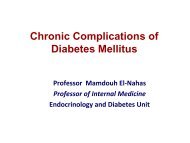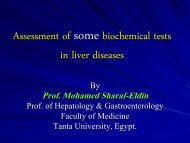Hirsutism & Virilization
Hirsutism & Virilization
Hirsutism & Virilization
You also want an ePaper? Increase the reach of your titles
YUMPU automatically turns print PDFs into web optimized ePapers that Google loves.
By<br />
Prof.Dr. Nabil Lymon<br />
Head of Internal Medicine Department
Definitions:<br />
• <strong>Hirsutism</strong>:<br />
• Is the presence of terminal hair in androgendependent<br />
sites where hair does not normally<br />
grow in women.<br />
• This hair growth is located predominantly on<br />
midline portions of the body, including the<br />
face, chest abdomen, and inner thigh.<br />
• hypertrichosis: which simply indicates<br />
generalized increase body hair (nonsexual hair).<br />
It can be seen in anorexia nervosa, porphyria<br />
cutanae tarda, and underlying malignancy and<br />
is caused by certain drugs (e.g. ciclosporin,<br />
minoxidil)
<strong>Virilization</strong>:<br />
• Is hirsutism associated with other signs of<br />
hyperandrogenism, such as increased<br />
muscle mass, clitorimegaly, temporal balding,<br />
voice deepening, and increased libido.<br />
• It can also be associated with signs of<br />
defeminization, such as decreased breast<br />
size and loss of vaginal lubrication.
Hair Growth Cycle<br />
1. Growth phase: Anagen.<br />
2. Rapid involution and shedding phase: Catagen.<br />
3. Quiescent phase: Telagen.<br />
• The length of the hair is determined by the<br />
duration of anagen.<br />
• This is longest in scalp hair (3 years) and<br />
shortest in forearm hair.
Types of Hair<br />
1. Lanugo hair: It is soft, short hair covering<br />
the fetus that is shed in late gestation and<br />
during the neonatal period.<br />
2. Vellus hair: It is soft, fine, unpigmented hair<br />
that covers apparently hairless areas of the<br />
body.<br />
3. Terminal hair: It may be: sex hormone<br />
dependent hair as the long, coarse,<br />
pigmented hair that may grow in response to<br />
sex hormones (e.g., over the chin and<br />
abdomen of men) or may be sex hormoneindependent<br />
as eyebrows and eyelashes.
Factors affecting hair growth:<br />
• Hair growth, and thus hirsutism, is regulated<br />
by:<br />
1. Number and concentration of hair<br />
follicles.<br />
• This varies according to racial and<br />
ethnic back-ground but not gender.<br />
• For example, Asian women generally<br />
have low concentrations of hair<br />
follicles, and hirsutism is rarely seen in<br />
these individuals.
2. Degree to which hair follicles are sensitive<br />
to androgens and able to convert vellus<br />
hairs to terminal hairs.<br />
3. Degree of 5 ɑ-reductase activity in the<br />
skin, which determines local androgen<br />
activity.<br />
4. Ratio of growth to resting phases in<br />
affected hair follicles.<br />
5. Thickness and degree to which individual<br />
hairs are pigmented.
Pathophysiology of <strong>Hirsutism</strong><br />
• A combination of the following factors results<br />
in hirsutism:<br />
1. Increased concentration of serum<br />
androgens, especially free testosterone.<br />
2. Decreased levels of SHBG, resulting in<br />
increased bioavailable androgen.<br />
3. Increased activity of 5 ɑ-reductase.
Sources of androgens in females:<br />
• In women, androgens are mainly produced<br />
by:<br />
1. The adrenal gland.<br />
2. The ovary.<br />
3. Peripheral transformation.
Type of androgens are:<br />
1. Testosterone is the most potent androgen.<br />
2. Androstenedione.<br />
3. Dehydroepiandrosterone (DHEA).<br />
4. DHEA sulfate (DHEAS).
I- Testosterone<br />
• Total testosterone: Levels in women are<br />
usually less than 70 ng/dL.<br />
• Sources:<br />
a) Ovarian 25% (in stroma and follicles).<br />
b) Adrenal origin 25%.<br />
c) Peripheral transformation of<br />
androstenedione to testosterone 50%.
• Most testosterone in the blood circulates<br />
bound to albumin (19%) or to sex hormonebinding<br />
globulin (SHBG) (80%).<br />
• Free testosterone<br />
a) In normal women (1%).<br />
b) In hirsute women (2%).<br />
c) In men (2 to 3%).<br />
• Androgenicity depends mainly on the<br />
unbound fraction of testosterone because<br />
this represents the active form of the<br />
hormone.
II- Sex Hormone-Binding Globulin<br />
(SHBG)<br />
A. Factors that decrease plasma SHBG<br />
1. Obesity.<br />
2. Increased androgen production.<br />
3. Hyperinsulinemia.<br />
4. Hyperprolactinaemia.<br />
5. Corticosteroid therapy.<br />
6. Hypothyroidism.<br />
7. Acromegaly.
B. Factors that increase plasma SHBG<br />
1. Estrogen therapy.<br />
2. Pregnancy.<br />
3. Hyperthyroidism.<br />
4. Liver cirrhosis.<br />
• In general, hirsute women have reduced<br />
serum concentrations of SHBG.
III- 5 α-Reductase<br />
• 5 α-Reductase converts testosterone to<br />
dihydrotestosterone (DHT) in androgensensitive<br />
tissues such as hair follicles and<br />
skin.<br />
• Levels of this enzyme are significantly<br />
elevated in the skin of hirsuted women<br />
compared with non hirsuted.<br />
• The enzyme activity is partly stimulated by<br />
elevated circulating testosterone levels.<br />
• Dihydrotestosterone is responsible for<br />
stimulating hair growth and is two to three<br />
times as potent as testosterone.
Causes of Hirsuitism<br />
PCOS 75%<br />
Idiopatic hirsutism 15%<br />
Adrenal hyperplasia 3%<br />
Cushing’s disease 1%<br />
Hyperprolactinemia 1%<br />
Tumor of the ovary 1%<br />
Tumor of the adrenal 0,1%<br />
Medications 1%
Diagnosis of <strong>Hirsutism</strong>
History:<br />
1) Onset of hirsutism<br />
• Gradual onset of hirsutism which is<br />
associated with acne, oily skin, weight<br />
gain, and irregular menstrual cycles. This<br />
suggests an underlying endocrine<br />
condition, such as polycystic ovary<br />
syndrome (PCOS).<br />
• Abrupt onset or rapidly worsening<br />
hirsutism with signs of virilization should<br />
direct concern for an androgen-producing<br />
tumors.
2) Presence or absence of virilization.<br />
3) Drug ingenstion.<br />
• Drugs are usually associated with<br />
hypertrichosis, but androgenic drugs (e.g.,<br />
steroids and phenytoin) may cause<br />
hirsutism.<br />
4) Family history.<br />
• A family history of hirsutism may indicate<br />
an inherited disorder (i.e., familial<br />
hypertrichosis).
5) Ethnic background.<br />
• The pattern of hair growth is genetically<br />
predetermined and is associated with<br />
differences in 5 α-reductase activity at<br />
hair follicles.<br />
6) Local trauma. Changes in skin and hair<br />
growth may occur.<br />
7) Regularity of menstrual cycles.<br />
• Patients with regular menstrual cycles<br />
and hirsutism often have idiopathic,<br />
ethnic, or familial hirsutism.<br />
8) History of infertility.
Differential Diagnosis of<br />
<strong>Hirsutism</strong>
1- Polycystic ovary syndrome:<br />
• This heterogeneous endocrine, metabolic,<br />
and genetic disorder is seen in 5 to 10% of<br />
the general population and is the cause of<br />
androgen excess in 65 to 85% of hirsute<br />
patients. This syndrome is characterized by<br />
hyperandrogenism, oligomenorrhea or<br />
amenorrhea (caused by chronic anovulation),<br />
and obesity.<br />
• It is associated with insulin resistance.<br />
Patients usually present with hirsutim,<br />
menstrual irregularity and infertility.
a) The fundamental pathophysiologic defect is<br />
not known.<br />
b) Increased production of androgens may<br />
result from:<br />
• Increased secretion of luteinizing hormone<br />
(LH) from the anterior pituitary, leading to<br />
increased ovarian androgne production.<br />
• Insulin resistance and compensatory<br />
hyperinsulinemia, stimulate ovarian and<br />
adrenal androgen production by direct and<br />
indirect mechanisms.
c) Gonadotropin regulation of the menstrual<br />
cycle is disrupted, leading to oligo-ovulation or<br />
anovulation and menstrual irregularity.<br />
d) Increased androgen levels inhibit follicular<br />
development in the ovary; thus, multiple.<br />
Peripheral, small atretic follicles are produced.<br />
These “polycystic ovaries” are therefore a<br />
reflection of the hormonal environment within<br />
the ovary rather than the cause of the<br />
disorder.<br />
e) Affected patients are at increased risk for<br />
endometrial hyperplasia or cancer, glucose<br />
intolerance, type 2 diabetes mellitus,<br />
hyperlipidemia, and cardiovascular disease.
2- Idiopathic hirsutism:<br />
• This condition, accounts for 15 to 30% of<br />
hirsute women.<br />
• It is caused by end-organ (skin)<br />
hypersensitivity to androgens.<br />
• It is characterized by:<br />
a. Regular ovulatory menstrual cycles.<br />
b. Normal circulating androgen levels.<br />
c. Increased peripheral conversion of<br />
androgens caused by increased skin 5 α-<br />
reductase activity.
3- Non classical (adult-onset) adrenal<br />
hyperplasia:<br />
• This condition is present in approximately 1%<br />
of hyperandrogenic women.<br />
• There is deficiency in activity of adrenal<br />
enzymes and thus formation of excess cortisol<br />
precursors (e.g., 17-hydoxyprogesterone and<br />
androstenedione) which leads to increased<br />
production of androgens. The most common<br />
enzyme deficiency is 21-hydroxylase.<br />
• Inheritance is autosomal recessive, and<br />
occurrence is increased in Ashkenazi Jews.
4- Cushing syndrome:<br />
• Adrenocortical hyperfunction leads to:<br />
a. Excess production of<br />
corticosteroids.<br />
b. Hyperandrogenism.<br />
c. Menstural irregularities.<br />
d. Glucose intolerance.<br />
e. Obesity.
5- Androgen-producing tumors:<br />
• These are associated with:<br />
a. Sudden-onset hyperandrogenic state.<br />
b. Rapid progression.<br />
c. Frank virilization.<br />
• Types are:<br />
a. Ovarian tumors (e.g., Sertoli-Leydig<br />
cell tumor, thecoma, luteoma of<br />
pregnancy).<br />
b. Adrenal tumors.
6- Disorders of pituitary origin<br />
• Hyperprolactinemia.<br />
• Acromegaly.<br />
7- Androgenic drug exposure<br />
• Without virilization: phenytoin, diazoxide,<br />
corticosteroids, cyclosporine.<br />
• With potential virilization: anabolic steroids,<br />
androgen therapy.
8- Y-containing mosaic and incomplete<br />
androgen insensitivity.<br />
• These patients show signs of androgne<br />
stimulation at puberty.<br />
9- HAIR-AN Syndrome:<br />
• There is hyperandrogenism, insulin<br />
resistance, and acanthosis nigricans<br />
syndrome.<br />
• This condition is similar to PCOS, but<br />
patients have a greater degree of insulin<br />
resistance and hyperinsulinemia.<br />
• This disorder is often inherited.
Laboratory Evaluation<br />
of <strong>Hirsutism</strong>
1) Serum total testosterone:<br />
• It is a marker of ovarian and adrenal<br />
activity.<br />
• Total testosterone levels greater than 200<br />
ng/dL:<br />
• This suggest androgen-producing tumor.<br />
• In this condition, imaging is indicated:<br />
a. Pelvic ultrasound is best to provide<br />
and image of the ovaries.<br />
b. CT or MRI views the adrenal glands.<br />
• Total testosterone levels less than 200<br />
ng/dL are associated with anovnlation and<br />
hirsutism. The most likely diagnosis is<br />
PCOS.
2) Serum DHEAS (a marker of adrenal<br />
activity):<br />
It is almost exclusively produced by<br />
adrenal glands and reflects adrenal androgen<br />
activity.<br />
• High level suggest an adrenal tumor.<br />
• Moderately elevated DHEAS levels may<br />
occur with anovulation , PCOS, or adrenal<br />
hyperplasia.<br />
• Normal DHEAS levels indicate that<br />
adrenal disease is less probable and that<br />
ovarian androgen production is more<br />
likely.
3) Elevated levels of serum androstenedione<br />
(a marker of ovarian activity): suggest<br />
ovarian disease.<br />
4) Serum basal 17-hydroxyprogesterone (17-<br />
OHP):<br />
17-OHP is elevated in 21-hydorxylase<br />
deficiency, the most common from of nonclassical<br />
(adult onset) adrenal hyperplasia.
5) Oestrogen levels. Estradiol is usually<br />
normal in PCOS, but estrone levels (which<br />
are rarely measured) are elevated because<br />
of peripheral conversion. Levels are variable<br />
in other causes.<br />
6) Increased production of cortisol:<br />
It is associated with Cushing syndrome.<br />
Diagnosis is made by 24-hour urinary-free<br />
cortisol excretion.
7) Gonadotropins:<br />
• An elevated LH: FSH ratio suggests<br />
PCOS.<br />
• However, this finding is not present in<br />
approximately 40% of patients with PCOS.<br />
8) Thyroid-stimulating hormone and<br />
prolactin.
Treatment
• The most complete & effective treatment for<br />
hirsutism is: (Hormonal suppression of hair<br />
growth + Mechanical hair removal)<br />
• Treatment of the causes:<br />
• Removal of ovarian or adrenal tumors.<br />
• Elimination of drugs suspected to contribute<br />
to the abnormal hair growth.<br />
• Treatment of Cushing syndrome, thyroid<br />
disease, or hyperprolactinemia.
• Suppression of androgen synthesis:<br />
1. Combined oral contraceptives:<br />
• Dose: Low-dose formulations 20µg<br />
preparations.<br />
• Action:<br />
• Estrogen & progestin: ↓ gonadortopin<br />
↓ ovarian androgen.<br />
• Estrogen: (++) ↑ SHBG.<br />
• Progestin: Displace active androgens<br />
at the hair follicle + (--) 5a-reductase<br />
activity.<br />
• Results: results within 1to 3 months
2. Medroxyprogesterone acetate:<br />
• Dose: 150 mg intramuscularly every 3 months.<br />
• Action: Progestin: as above (when COCs are<br />
contraindicated)<br />
3. Gonadotropin-releasing hormone (GnRH)<br />
agnoists:<br />
• Action: (--) hypothalamic-pituitary-ovarian axis<br />
↓ ovarian steroidogenseis.<br />
• Indications: severely androgenized patients<br />
refractory to other therapies.<br />
4. Corticosteroids:<br />
• Indications: severe cases of adrenal hyperplasia<br />
(CAH).
• Androgen-receptor blockers:<br />
• Action: (--) binding of DHT to androgen<br />
receptor.<br />
• Types:<br />
• Others:<br />
• Spironolactone (aldosterone antagonist)<br />
• Flutamide.<br />
• Cyproterone acetate.<br />
• Cimetidine: androgen receptor blocker.<br />
• Ketoconazole: (--) adrenal & ovarian<br />
androgen synthesis.<br />
• Insulin-senstizing agents: e.g, metformin<br />
• 5a-reductase inhibitors.
• Supportive measures:<br />
• Shaving, tweezing, waxing, and use of<br />
depilatories temporary measures, which<br />
may need to be repeated daily.<br />
• Bleaching is effective for mild hair growth.<br />
• Electolysis: permanent destruction of hair<br />
follicles: Multiple treatment are needed.<br />
• Laser epilation: provides directed damage<br />
to hair follicles, which temporarily or<br />
permanently remove terminal hair, can be<br />
used over a larger area.









